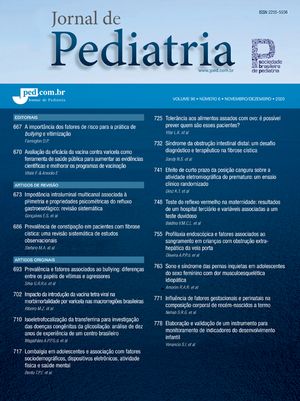
To review the new options in insulin therapy for controlling diabetes mellitus in children and adolescents.
SourcesArticles indexed in PubMed were located using the search terms insulin analogs in children and adolescents and reviewed. Information was also obtained from American Diabetes Association and Sociedade Brasileira de Diabetes consensus documents.
Summary of the findingsInformation is presented on new analogs of insulin and, for purposes of comparison, the other insulin modalities currently available are also reviewed, focusing on insulin therapies which attempt to approximate basal-bolus treatment strategies to physiology. With the objective of obtaining improved metabolic control, more and more children are being put on multiple daily injection regimes or using continuous subcutaneous insulin infusion. It is difficult to achieve optimum glycemic control in children due to the increased risk of hypoglycemia resulting from the great variability in dietary intake habits and in physical activity levels. With diabetes type 1, if rapid-acting analogs are given subcutaneously in bolus, they generally reduce hypoglycemia episodes and postprandial glycemia levels, compared with regular human insulin, while basal analogs tend to reduce particularly the number of episodes of nocturnal hypoglycemia.
Conclusions: Although the benefits to individual metabolic and clinical outcomes appear modest, the majority of studies demonstrate benefits when insulin analogs are used in the treatment of diabetes type 1 or 2.
Although the benefits to individual metabolic and clinical outcomes appear modest, the majority of studies demonstrate benefits when insulin analogs are used in the treatment of diabetes type 1 or 2.
Revisar as novas opções nas terapêuticas insulínicas para controlar o diabetes melito de crianças e adolescentes.
Fontes dos dadosForam revisados artigos indexados no PubMed buscados conforme as palavras insulin analogs in children and adolescents e incluídas informações contidas nos consensos da American Diabetes Association e Sociedade Brasileira de Diabetes.
Síntese dos dadosSão apresentadas informações sobre os novos análogos da insulina e, para comparação, são também revisadas as outras diferentes modalidades de insulina que estão atualmente disponíveis, focalizando nas terapias insulínicas que tentam fornecer uma aproximação mais fisiológica das estratégias basal-bolos no tratamento. Com o objetivo de obter melhor controle metabólico, mais e mais crianças estão em regimes de múltiplas injeções diárias ou usando infusões subcutâneas contínuas de insulina. Atingir controle glicêmico ótimo nas crianças é difícil devido ao maior risco de hipoglicemia decorrente da grande variabilidade em hábitos de ingerir alimentos e em níveis de atividade física. Se aplicados em bolos, subcutâneos, no diabetes tipo 1, os análogos de ação rápida, comparados com insulina humana regular, geralmente reduzem os episódios de hipoglicemia e glicemia pós-prandial, enquanto os análogos basais tendem a reduzir particularmente a hipoglicemia noturna.
ConclusãoEmbora os benefícios nos desfechos individuais metabólicos e clínicos pareçam modestos, a maioria dos estudos demonstra benefícios quando são usados análogos de insulina no tratamento do diabetes tipo 1 ou 2.









